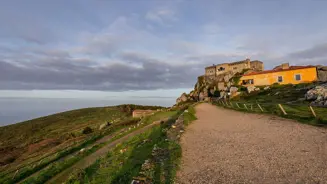The History of the Sanctuary of Peninha

It is impossible to disconnect the history of this sanctuary from its legend. This tells how, during the reign of King João III, a deaf and very poor shepherd, resident in Almoinhas Velhas, who commonly grazed his sheep in these surroundings, noticed one of them was missing. From afar, he spotted a lady who was bringing with her his lost sheep. Being dumb, the shepherd expressed his thanks as best he could. The lady asked him for a little bread but the shepherd had to tell her that he had no bread as he was, indeed, very poor.
The lady then told him that, when he arrived home, he was to call for his mother and ask for some bread. The shepherd, who knew that there was no bread in his house and knowing that he was dumb, would be unable to call for his mother, explained to the lady that it would be impossible to do any such thing. After various insistences, the shepherd agreed to try.
On arrival, he called for his mother and, miraculously, his voice sounded out. He explained what had happened and together they went to search the house for bread. In a chest, they found enough bread to feed the entire village and bring the time of hunger to an end.
In thanks, the entire village proceeded up the hill to where he had met the lady and, on the exact site of the event, they erected a statue of Our Lady. Henceforth, this became a place of sacred worship.
Towards the end of the 17th century, Brother Pedro da Conceição, with the support of donations from the faithful and King Pedro II, oversaw the building of a chapel dedicated to Our Lady of Peninha, alongside the houses built to provide shelter for pilgrims to the site.
However, this was not the first place of worship built on a site with its origins lost to time. It is known that in the 12th century there was already a hermitage there, then dedicated to Saint Saturnin, the work of Pêro Pais, officer and standard-bearer to the first king of Portugal, Afonso Henriques.
In 2017, Parques de Sintra, the ICNF (the National Institute of Nature and Forestry Conservation) and EMAC (Cascais Municipal Environment Company) signed a protocol for the management of Quinta da Peninha. Under this agreement, Parques de Sintra takes on responsibility for the rehabilitation and management of the built complex making up the Sanctuary of Peninha in order to ensure the appropriate conditions for the public enjoyment of this heritage.
